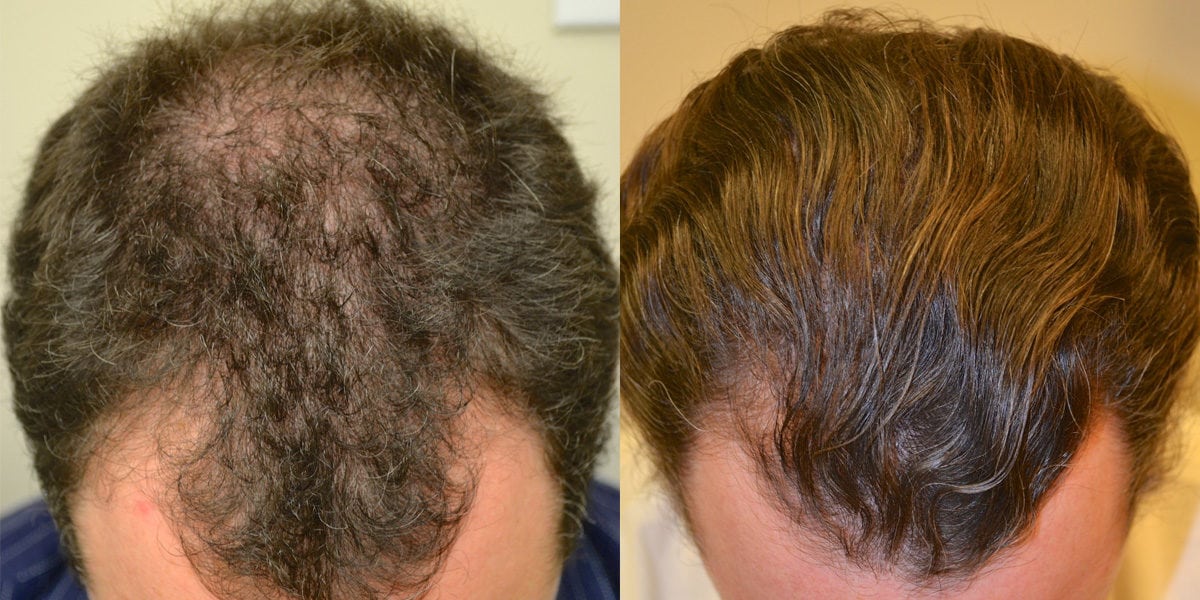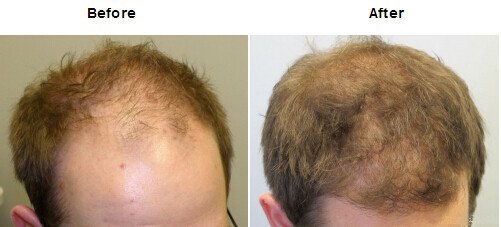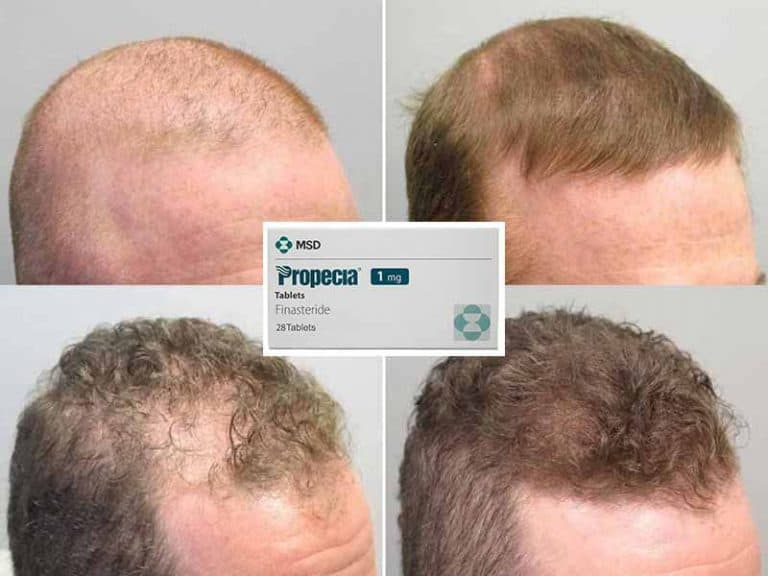How Finasteride Stops Baldness
Our body naturally synthesizes DHT through testosterone . An enzyme called 5-alpha-reductase attaches to finasteride and converts it to DHT. There are other biochemical pathways of DHT production, but the 5AR pathway is by far the most important one.
Without 5AR, the body can only make a tiny fraction of its normal DHT production.
This is where finasteride comes in. In simplest terms, finasteride works by inhibiting the enzyme 5-alpha-reductase .
Finasteride achieves this because its chemical structure is similar enough to testosterone that it tricks the 5AR into binding with it. Once they bind to finasteride, the 5AR molecules are irreversibly trapped, and become biologically inactive.
The result is that DHT levels in the body plummet .
With low DHT levels in the system, the hair follicles get a respite. The hair follicle miniaturization process freezes, and hair loss stops. For around two-thirds of men, this drop in DHT will also be enough for them to regrow some new hair .
Theres No Established Finasteride
Again, according to Jeff Donovan, a dermatologist in Vancouver, theres no known direct link between finasteride use and breast cancer.
He cites a Prostate Cancer Prevention trial, among others, to validate his claim. That study had over 18,000 male participants and lasted for 7 years.
No increased risk for breast cancer was observed in the finasteride group vs. the placebo group.
How Long Does It Take Propecia To Work
Dr. Lopresti notes that Propecia must be used daily for at least 18 months to clinically assess the results of treatment. With that being said, patients can start seeing results as early as 3 or 4 months.
From there, Dr. Sieber says that the effects build up around 12 months before they begin to plateau. The hair is still being protected, but increased hair thickness may level out around 12 months or so, he says.
Also Check: How To Keep Hair From Thinning
Finasteride Results On A Receding Hairline
Finasteride will work on all areas of the scalp affected by male pattern baldness, including the hairline. The best way to assess the results from finasteride is to take pictures at regular intervals. You should start to notice a difference at around the 3-month mark, and results should be clearly visible after 6 months. The before and after pictures will give you a good indication whether finasteride is working for you or not. If you have not experienced any positive results after 1 year, you should stop taking treatment as it is unlikely that finasteride will work for you. Having said this, finasteride does not just work to regrow hair, but it can also prevent further hair loss. Sometimes this is difficult to assess, but if you were losing hair before starting treatment, and your hair loss has decreased, after starting treatment, it is likely that finasteride is working for you.
Who Can Use Finasteride

Finasteride is the generic name for the prescription medication Propecia, which is used to treat male pattern baldness. It specifically helps with gradually thinning hair around the temples and at the top of the head. While studies have shown finasteride can help with baldness in men, it is not used to treat hair loss in women or children. It is only licensed to treat hair loss in males aged 18 or over.
Recommended Reading: Does Prose Help With Hair Loss
Taking Finasteride With Minoxidil
Minoxidil is the only other hair loss product on the market that is recommended by the British Association of Dermatologists.
Minoxidil is applied to the scalp and areas suffering hair loss. However, it has been shown that topical Minoxidil is less effective than Finasteride for male pattern hair loss.
Taking both together is likely to have a synergistic effect as the medicatons work in different yet complimentary ways.
Finasteride can be combined with minoxidil in a topical solution for those not wishing to take either medication orally.
Minoxidil can be given orally with Finasteride for those wishing to take oral medicaitons only.
Combine Finasteride With Minoxidil
Minoxidil is a medication that comes as a foam or liquid that you rub onto your scalp. Scientists believe it helps stimulate hair growth by increasing the flow of blood and nutrients to hair follicles.
A clinical trial of 100 people with androgenic alopecia found that using finasteride and minoxidil together was more effective than using either one alone . If youre interested in trying this combination, speak with your healthcare provider.
Recommended Reading: What Straightener Is Best For Thin Hair
Who Should Not Take Finasteride
Do not take finasteride if you:
- are pregnant or may become pregnant. Finasteride may harm your unborn baby. Females who are pregnant or who may become pregnant should not come in contact with broken or crushed finasteride tablets. If a pregnant woman comes in contact with crushed or broken finasteride tablets, wash the contact area right away with soap and water. If a woman who is pregnant comes into contact with the active ingredient in finasteride, a healthcare provider should be consulted. o If a woman who is pregnant with a male baby swallows or comes in contact with the medicine in finasteride, the male baby may be born with sex organs that are not normal.
- are allergic to any of the ingredients in finasteride.
Is There A Topical Finasteride
If youve read this article, you know that there is a topical version of this popular hair loss medicine. While it is not FDA approved, you can purchase it in the US through the providers weve reviewed. And from the medical research that weve reviewed, it seems likely that the version you apply to your skin is less likely to cause adverse, systematic side effects vs. the oral medication.
Read Also: Does Everyone Experience Postpartum Hair Loss
Why Isn’t Propecia Working For Me
Everyones bodies are different, and while one treatment might work for 1 person it may not work for another. If after 3-6 months of taking Propecia youve not seen any improvement in your hair loss, its worth speaking to your clinician. They will be able to advise what the best next steps are.
Regaine is a popular hair loss treatment. The active ingredient in Regaine helps to slow hair loss and encourage regrowth. Its usually applied to the head in a foam.
Usage Of Lllt Devices
LLLT is short for low-level laser therapy.
Youve probably seen these devices – they look like wands and by pointing them at the scalp, you can increase blood flow to hair follicles and aid in its growth. LLT has been cleared by the FDA as a certified method of treating hair loss, and combining it with Finasteride and Minoxidil improves results.
Recommended Reading: Do Eating Disorders Cause Hair Loss
Is It Safe For Women To Use Finasteride
Because the FDA hasnt approved finasteride as a treatment for female pattern hair loss, there are no large-scale clinical trials on its safety like there are for men.
This means that we cant yet confidently state whether or not finasteride is completely safe for women to use.
Most of the current research on finasteride shows that its generally safe, with few or no major side effects.
For example, in the studies mentioned above, researchers generally found that finasteride was safe for women to use.
A large-scale review of research on finasteride in women reached a similar conclusion, but noted some cases of sexual side effects and other issues.
More specifically, some women who used finasteride for hair loss reported a reduced sex drive, irregular menstruation, acne, headache, dizziness, folliculitis and increased body hair growth.
Its worth noting that these side effects were mild and transient, meaning they improved on their own over the course of treatment.
Aside from minor local effects, such as irritation and itching, no side effects have been linked to the use of topical finasteride in women.
Overall Its Been Well

Again, the data is somewhat limited.
But most female users appear to take the drug without any major complaints.
Some even continue using the drug when they experience side effects, due to its benefits outweighing the risks/adverse effects.
Speaking of side effects, the next couple of points will cover some of the most common side effects associated with finasteride.
You May Like: Can Dry Itchy Scalp Cause Hair Loss
The Verdict: Which Topical Finasteride Product Is Best
So who sells the best topical Finasteride online: Hims, Happy Head or Strut?
Our overall recommendation for men seeking topical Finasteride is to try Hims. They have a rock-solid telemedicine practice , and its a trusted online medicine provider with reliable shipping. You can get started now on their topical Fin to try Hims now.
If you want to do everything you possibly can to fight your hair loss, then Happy Head might be your best bet. They offer the highest concentration of finasteride + minoxidil, and also include a third active ingredient, retinoic acid, to promote growth at the site of application. At $79/month, we acknowledge its more expensive than Hims or Strut as well, and thus not accessible for all.
Overall, we recommend Hims spray let us know if youve tried them and how its gone for you in the comments below. Wed be remiss if we didnt also mention hims PE spray another awesome topical product, albeit for a different mens health condition: premature ejaculation.
What About Finasteride Side Effects
Like almost all medications, finasteride can cause side effects. Most of the adverse effects of finasteride are mild, although some may have an impact on your quality of life.
Potential side effects of finasteride include:
-
Inability to get or maintain an erection
-
Pain or discomfort that affects the testicles
-
Problems related to ejaculation, such as decreased ejaculatory volume
-
Changes in mood or depression
Although its uncommon in the low-strength version of finasteride thats used to treat hair loss, some men who use Proscar, a stronger version of finasteride for BPH, also report side effects such as breast tenderness and skin rashes.
Sexual side effects, such as erectile dysfunction, difficulty ejaculating and a weaker sex drive, can sound alarming.
However, its important to look at these side effects in context before you write off finasteride as a hair loss treatment.
Even in studies of Proscar, a high-strength 5mg version of finasteride, only a small percentage of men report these side effects.
For example, in clinical trials of finasteride for BPH, just over eight percent of men reported an effect on their erections, with 6.4 percent and 3.7 percent of men reporting decreases in libido and a reduced ejaculation volume, respectively.
Other finasteride side effects, such as breast tenderness and rash, were reported by less than one percent of men who used finasteride in clinical trials.
You May Like: What Hormone Causes Hair Loss
What Is Finasteride And Does It Work
Finasteride is a medication that blocks a potent form of testosterone called DHT . DHT can attack hair follicles, causing them to shrink and produce smaller, thinner hairs. By blocking DHT, finasteride can slow, stop, or even reverse hair loss.
In clinical trials, finasteride stopped hair loss in 83% of people with male pattern baldness who took it for two years . But you can see results from finasteride within as little as three to four months.
Other Treatments For Hair Loss In Men
For most men, finasteride is an effective option for treating and preventing hair loss from male pattern baldness.
However, its not the only hair loss treatment thats available. Other affordable and effective hair loss treatment options include:
-
Minoxidil. A topical medication, minoxidil helps to improve blood flow to the scalp and stimulate hair growth. Research shows that minoxidil is particularly effective when its used at the same time as finasteride. We offer minoxidil solution and minoxidil foam online. You can also purchase finasteride and minoxidil together in our Hair Power Pack.
-
Hair loss prevention shampoo. Many shampoos, including those that contain active ingredients such as saw palmetto and ketoconazole, are formulated to prevent excess hair shedding and promote optimal hair growth. Our Hair Thickening Shampoo uses saw palmetto to target DHT at the scalp level and promote volume and moisture.
Recommended Reading: How To Prevent Hair Loss At A Young Age
The Risks And Downsides
1. Side Effects may be more common than we realized.
2. The very small risk of persistent sexual side effects and/or post-finasteride syndrome.
3. If you stop taking it, youll lose any hair you kept or regrew with the drug within about 12 months.
4. The unknown is another downside, given that Propecia is still a relatively new medication. The general consensus in the medical community is that its a safe and well-tolerated medication for the most part, but that could change in the future.
Can Women Take Propecia
No, women should not take Propecia, since its only FDA-approved for men.
There can be the potential of birth defects if a woman of childbearing age takes Propecia, Dr. Lopresti states. However, all 3 doctors note that it is possible for post-menopausal women to be given it off-label, but there is limited evidence in efficacy. Anyone looking to take Propecia should consult their doctor prior to seeking a prescription for it.
Also Check: Can Hidradenitis Suppurativa Cause Hair Loss
Finasteride For Female Hair Loss Conclusion
If youre experiencing moderate to severe pattern hair loss, finasteride is a treatment that can definitely help. But it comes with risks, particularly if youre of child-bearing age.
While the data is limited, its a medication that has a track record and overall, the research indicates that the drug is well-tolerated in women.
Women under the age of 60 responded best to finasteride. It also worked fairly well for women between the ages of 60 and 70 in the 2013 study I cited above. If youre over 70, its less likely to work as well for you.
Finasteride is undoubtedly one of the 12 most effective treatments for female hair loss at this time. Whether the risks outweigh the benefits of this drug is something youll have to think about for yourself, then discuss with a physician if desired.
Finasteride For Women: Can Women Use Finasteride For Hair Loss

Medically reviewed by Kristin Hall, FNP
While hair loss is usually associated with men, its far from uncommon for women to experience hair shedding and even permanent hair loss at some point in life.
In fact, research suggests that approximately 40 percent of women develop female pattern hair loss, or FPHL, by the age of fifty.
If youve looked into treatments for hair loss, you may have heard of finasteride a medication thats often used by men with male pattern baldness.
Currently, the FDA hasnt approved finasteride for women.
However, research into its effects in women is ongoing and its possible that a form of finasteride could be approved as a treatment for female pattern hair loss at some point in the future.
Below, weve discussed what finasteride is, as well as how it works as a treatment for hair loss in men.
Weve also looked at the most recent research into the effects of both oral and topical finasteride in women.
Finally, weve listed the other treatment options that are currently available if youre losing hair due to female pattern hair loss.
Recommended Reading: What Is Roman For Hair Loss